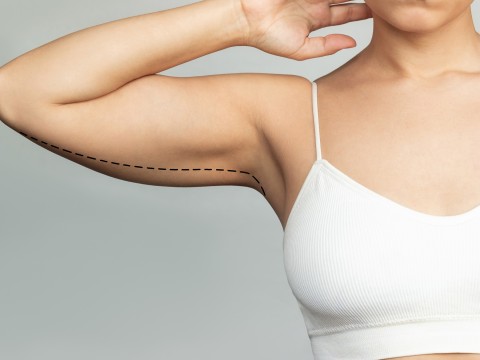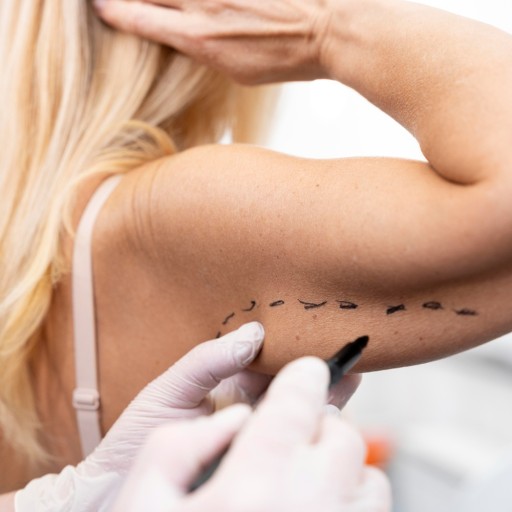Quote of Alara Health Group
Arm Lift Surgery: Everything You Need to Know About Brachioplasty
An arm lift, also known as brachioplasty, is a cosmetic surgical procedure intended to reshape and tighten the upper arms. With aging, weight loss, or genetics, many people develop loose skin in the upper arms. An arm lift can dramatically improve the contour and tone of the arms, giving them a more youthful and defined appearance. In this article, we look at what arm lift surgery is, who the candidate for such surgery is, the benefits, types of procedures, and the recovery process.
What is Arm Lift Surgery?
Arm lift surgery, also medically referred to as brachioplasty, is a surgical procedure that aims to remove excess skin and fat from the upper arms, thereby tightening the muscles beneath. The surgery is generally performed on people who have lost a lot of weight or those whose skin has lost its elasticity due to aging. The goal of brachioplasty is to create a smoother, more toned appearance by eliminating loose or sagging skin and improving arm contour.
While arm lifts are most commonly associated with post-bariatric patients who have lost massive amounts of weight, individuals of all body types and ages may benefit from this procedure if they have excess arm skin or fat resistant to diet and exercise.
Who Can Benefit from Arm Lift Surgery?
Brachioplasty, or an arm lift, is suited for anyone with extra skin and fat on the upper arm who would wish to create a youthful appearance with great muscle tone. Suitable candidates for this form of surgery:
People with Excess Skin Following Weight Loss: Usually, individuals who have undergone bariatric surgery or dieting that results in excessive weight loss leave behind them sagging skin in the arms. An arm lift removes this extra skin and offers a smoother contour.
Loose Skin in Older Adults: As we grow older, skin loses its elasticity, which can make it sag, especially in the arms. An arm lift rejuvenates the arm by removing the extra skin and tightening the tissues underneath.
Those with Resistant Fat: While one may go to the gym and eat healthy, fat deposits will not leave the upper arms. An arm lift is a way for one to get rid of resistant fat and thus have better definition of the arms.
Those Seeking Better Contour: The majority of people seek an arm lift to enhance the overall contour and look of one's arms, as most feel awkward with the sagging skin whenever they wear sleeveless clothes.
Types of Arm Lift Procedures
The type of arm lift procedure performed depends on the amount of excess skin and fat, as well as the patient’s specific goals. There are several variations of brachioplasty, including:
Traditional Arm Lift (Full Brachioplasty): The traditional arm lift is the most common procedure. It consists of an incision along the inner arm, from the elbow to the armpit. Excess skin and fat are removed, and the remaining skin is pulled tighter to create a more defined arm shape. This technique is ideal for patients with moderate to severe excess skin.
Mini Arm Lift: The mini arm lift is less invasive for patients with a small amount of excess skin or fat. The incision is usually smaller, in the upper arm near the armpit, and is suitable for patients with only mild sagging or for those who want more subtle results.
Arm Lift with the Assist of Liposuction: These procedures sometimes include liposuction during an arm lift to take out extra fat prior to skin tightening. This procedure can work well in individuals who have excess fat and not so much loose skin. That is a good option when one needs to get rid of stubborn deposits of fat.
Advantages of Arm Lift Surgery
There are many physical and emotional benefits that come along with arm lift surgery. Some of the main advantages of this procedure include:
Improved Contour and Definition: The main advantage of having an arm lift is that it improves the appearance of the arm. The surgery removes extra skin and fat, which makes the contour smoother and tighter with more definition.
Increased Confidence: Many people who undergo arm lift surgery experience a significant boost in self-esteem and confidence. The removal of loose skin and fat can help individuals feel more comfortable wearing sleeveless clothing or bathing suits without feeling self-conscious.
Long-lasting Results: With proper care, the results of an arm lift are long-lasting. The skin will remain firmer and tighter, especially if the patient maintains a healthy weight and lifestyle.
Improved Arm Function: The loose, sagging skin and excess fat may cause discomfort and a lack of confidence in using one's arm, mainly for physical activities. Removal of the excess tissue improves not only the appearance but also the functioning of the arm.
The Arm Lift Procedure: What to Expect
Arm lift surgery is usually done under general anesthesia, but patients can often go home the same day. It takes about 2-3 hours, depending on the size of the work area.
Here's what to expect during the arm lift surgery:
Incisions: The surgeon will make an incision on the inner arm, which either runs from the elbow all the way up into the armpit if the traditional arm lift is chosen, or only in the case of a mini arm lift. Additional small incisions can be made for liposuction in the case of fatty tissues.
Skin and Fat Removal: After making the incisions, the surgeon will remove the excess skin and fat. Sometimes, liposuction is used to give a better contour to the arms.
Closing the Incisions: Once the contour is achieved, the surgeon will close the incisions with sutures. The incisions will be carefully placed to minimize visible scarring, and the surgeon will use techniques to ensure the scars are as discreet as possible.
Bandaging and Dressing: Following the surgery, bandages or compression garments may be applied to help reduce swelling and support the healing process.
Recovery After Arm Lift Surgery
Recovery from arm lift surgery typically takes a few weeks, but the final results will be visible after several months. Here’s what to expect during the recovery period:
Initial Healing: In the first few days after surgery, patients may experience some swelling, bruising, and discomfort. Pain can be managed with prescribed medications, and patients are encouraged to keep their arms elevated to reduce swelling.
Compression Garments: To reduce swelling and help support the arms as they heal, patients are usually instructed to wear compression garments for several weeks. This will also aid in providing a smoother contour.
Return to Normal Activities: Most patients can return to work or light activities within 1 to 2 weeks after surgery, but more strenuous physical activities, including exercise and lifting heavy objects, should be avoided for at least 4 to 6 weeks.
Final Results: The final results of the surgery will be realized after some months when swelling has reduced and the arms have healed completely. Scars will fade with time but may always be there, depending on the magnitude of the surgery.
Possible Risks and Complications
Arm lift surgery is generally safe, but like all other surgeries, there are a few associated risks and complications. They include:
Infection: Infection is possible, as it is after any surgery. Infections can be avoided by following the aftercare instructions given and using antibiotics as prescribed.
Scarring: There is no way to avoid scarring after an arm lift; however, skilled surgeons make sure that noticeable scarring is reduced by placing the incisions in less conspicuous areas. Scars will lighten over time, but some patients may have more noticeable scars than others.
Sensation Changes: Some patients develop temporary or permanent changes in sensation around the arms. This usually resolves as the healing process continues.
Asymmetry: Slight asymmetry in the final results may occur in some cases, but this can be usually corrected with additional minor adjustments.
Is Arm Lift Surgery Right for You?
If sagging skin or excess fat in the upper arms bothers you, brachioplasty may be a superb solution. The procedure can significantly offer aesthetic benefits and a boost in confidence, especially to those who have lost a dramatic amount of weight or are experiencing the natural effects brought about by aging.
Before you decide to undergo an arm lift, make sure you seek consultation from a board-certified plastic surgeon if the procedure is suitable for you. He will check on your health, talk about your goals, and explain what you should expect from preparation to post-surgery.
Conclusion
An arm lift can dramatically improve the appearance of one's upper arms, a way for patients to develop more confidence and comfort within their bodies. Whether because of weight loss, aging, or other factors, there is a brachioplasty one can consider for long-term smoother and firmer arms. With proper planning, care by a skilled professional, and commitment to recovery, it's possible to achieve life-changing results from arm lift surgery.
- Abdominal liposuction
- Back Liposuction
- Blepharoplasty (Eyelid Surgery)
- Brazilian Butt Lift (BBL)
- Breast Augmentation
- Breast Augmentation with Tear Drop Implants
- Breast Correction
- Breast Implant Removal
- Breast Implants With Breast Lift
- Breast Lift
- Breast Reconstruction
- Breast Reduction
- Brow Lift
- Buccal Fat Extraction
- Butt Implants
- Buttock lift
- Buttock Reduction
- Cheekbone Reduction
- Chin Implant
- Chin Liposuction
- Health Insurance
-
Accommodation
- Online Healthy Life Assistant 9/5
- Post - Experience Follow Up 6 Month
-
Extra Privileges

- Health Insurance
-
Accommodation
- Online Healthy Life Assistant 24/7
- Post - Experience Follow Up 1 Year
- Pre-Treatment Doctor Consultation
-
Extra Privileges

 Private
Private
- Health Insurance
- Healthy Life Butler
- Post - Experience Follow Up 2 Year
- World-Famous Doctor Consultation
-
Extra Privileges
No suitable hotel found for the relevant dates!
* Price varies depending on extra and upgrade selections.
Suitable candidates for an arm lift are individuals with significant sagging skin on their upper arms, often resulting from weight loss or aging. Good candidates should be in overall good health and have realistic expectations about the outcomes.
As with any surgery, there are risks, including infection, scarring, and adverse reactions to anesthesia. It's crucial to discuss potential complications with your surgeon before the procedure.
Results are long-lasting, but aging and lifestyle factors can impact them. Maintaining a healthy lifestyle, including regular exercise and a balanced diet, can help preserve the results.
The recovery period varies, but patients typically need about 2-4 weeks to resume normal activities. Strenuous exercise may need to be avoided for a more extended period, as directed by the surgeon.




